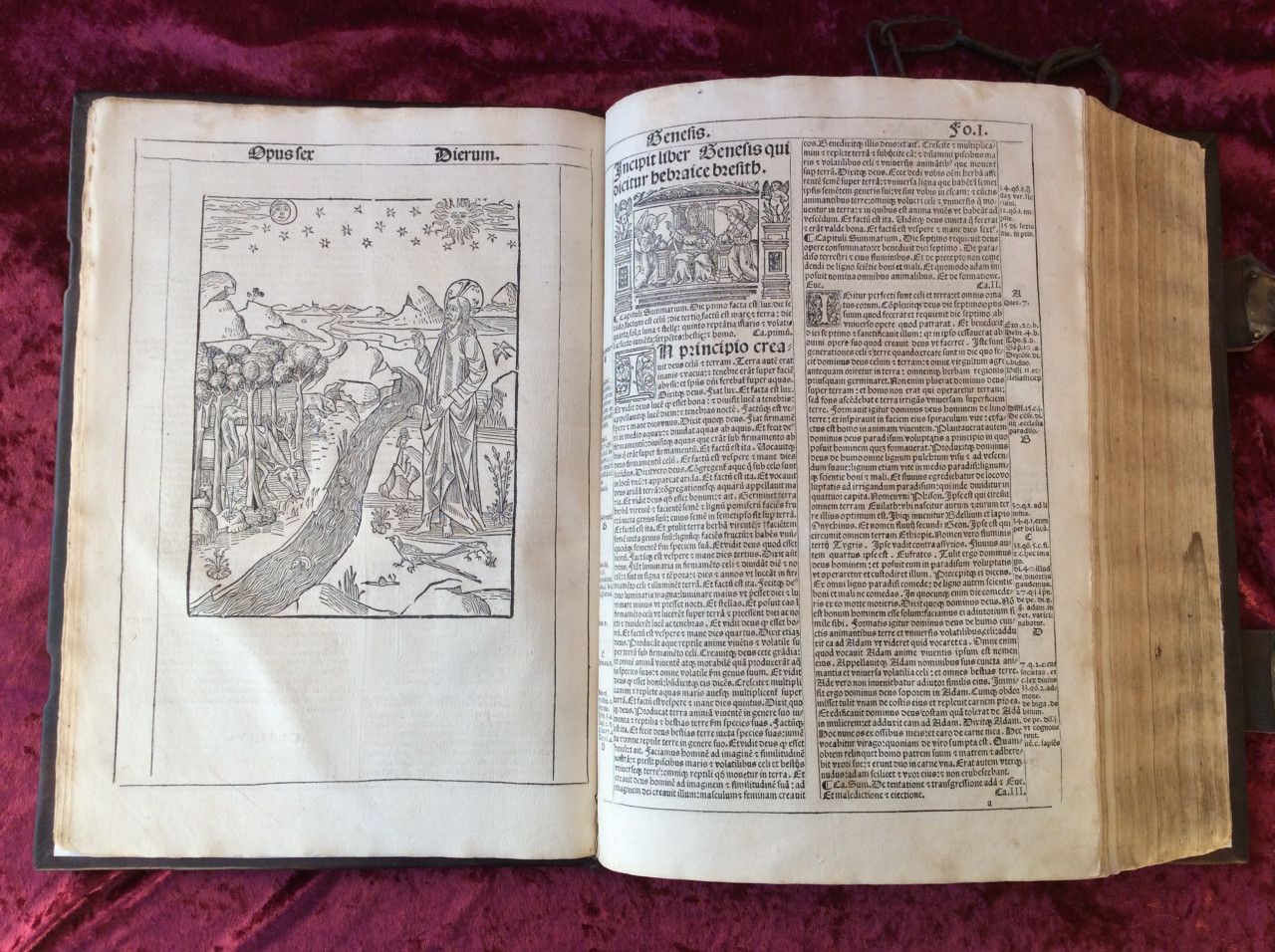Biblia Magna - Vulgata Lyon 1525Die lateinischen Bibeldrucke im Gefolge Gutenbergs
Biblia magna. Biblia cum concordantiis veteris et novi testamenti et sacrorum canonumJacques Mareschal, Lyon - 3. März 1525
Biblia cum concordantiis Veteris et Novi Testamenti et sacrorum canonum: necnon et additionibus in marginibus varietatis diversorum textuum: ac etiam canonibus antiquis quattuor Evangeliorum... Venundatur Lugduni in edibus Jacobi Mareschal alias Roland, 1525
Die Bibel mit Konkordanzen des Alten und Neuen Testaments und den heiligen Kanons: sowie Ergänzungen am Rand verschiedener Texte, sowie die alten Kanons der vier Evangelien... Die Bibel mit Konkordanzen wird in Lyon in der Ausgabe von Jacob Marshal alias Roland, 1525, verkauft
Seltene und frühe Ausgabe der berühmten Mareschal-Bibeln. Diese Ausgabe gibt den Text der Ausgaben von 1523 und 1525 von Jacques Mareschal wieder. Der Text wurde von Alberto Castellano mit historischen Notizen von Johannes de Gradibus (Giovanni Gradi) erstellt und kommentiert. Die Bibeln von Jacques Mareschal zeichnen sich durch den Reichtum ihrer Ikonografie aus.
Diese Ausgabe enthält einen großen Holzschnitt (194 x 141 mm), der die Erschaffung der Welt mit stehendem Gott darstellt, gezeichnet vom Meister der Ars moriendi von Jean Siber.
Das Alte Testament ist mit einer Serie von 98 Vignetten (38 x 57 mm) von G. le Roy in typografischen Rahmen geschmückt. Das Neue Testament ist mit einer Reihe von 23 Vignetten (57 x 37 mm) geschmückt, die sich von denen von 1523 unterscheiden; die Kanontafeln des Eusebius auf den Evangelien sind in Rot und Schwarz gedruckt in Kolonnaden mit Kapitellen, die von Halbkreisbögen gekrönt sind.
Weltweit sind in öffentlichen Bibliotheken nur 14 Kopien nachweisbar! Diesen Band aus einer bedeutenden Bibelsammlung Mitteldeutschlands konnte ich vor einiger Zeit für die Bibelausstellung erwerben.
Es wäre dann das 15. Exemplar von 23 Exemplaren nach meiner Zählung.
Die acht weiteren Exemplare Hier (koloriert USA) Hier und Hier (Sothebys) Hier (Bonhams, London) Hier Hier Hier (Frankreich) Hier Delaveau & Hillard, 812; Baudrier XI, 427; Gültlingen II, 226, Nr. 112; Braun, 124. Sammlung R.G.
Von 1456-1500 erschienen 94 Ausgaben - davon 81 reine Textausgaben und 13 mit Kommentaren
Zu diesen lateinischen Bibeldrucken bis 1500 siehe -> HIER
"Gutenberg seems to have given little thought to his choice of a copy text; he used one of many manuscripts of the Latin Vulgate (the fifth-century translation attributed to Jerome). Yet this unconsidered aspect of the printed book proved extremely influential. Virtually all of the Latin Bibles subsequently published in the fifteenth century (a total of some 94 editions, 81 in plain text and 13 with an accompanying commentary) took a printed bible as their model. The earliest editions used a copy of Gutenberg's Bible as their copy text; later fifteenth-century editions used either Gutenberg or one of thes earlier imitators. Unwittingly, therefore, Gutenberg played a major role in fixing the text of the Vulgate as the standard authorised text of Scripture. This would cast a long shadow over sixteenth-century efforts at revision" (Pettegree, The Book in the Renaissance [2010] 30).
|
